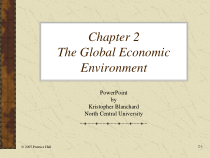 PPT
PPT
【文档说明】ch02TheGlobalEconomicEnvironment(全球营销,沃伦·.pptx,共(35)页,269.521 KB,由精品优选上传
转载请保留链接:https://www.ichengzhen.cn/view-282781.html
以下为本文档部分文字说明:
©2005PrenticeHallChapter2TheGlobalEconomicEnvironmentPowerPointbyKristopherBlanchardNorthCentralUniversity2-1©2005PrenticeHallIntroductiontoCh
apterMarketdefinition–Peopleororganizationswithneedsandwants;bothhavethewillingnessandabilitytobuyorsellThegloba
leconomicenvironmentplaysalargeroleinthedevelopmentofnewmarketsfororganizations2©2005PrenticeHallTheWorldEconomy–AnOverviewThenewrealities:–
Capitalmovementshavereplacedtradeasthedrivingforceoftheworldeconomy–Productionhasbecomeuncoupledfromemployment–Theworld
economy,notindividualcountries,isthedominatingfactor3©2005PrenticeHallTheWorldEconomy–AnOverviewThenewrealitiescontinued:–75-yearstruggleb
etweencapitalismandsocialismhasalmostended–E-Commercediminishestheimportanceofnationalbarriersandforcescompaniestore-ev
aluatebusinessmodels4©2005PrenticeHallEconomicSystems4maintypesofeconomicsystems–MarketCapitalism–Centrallyplannedsocialism–Cent
rallyplannedcapitalism–Marketsocialism5©2005PrenticeHallEconomicSystemsMarketCommandMarketCapitalismCentrallyPlannedCapitalismMarketSocialism
CentrallyPlannedSocialismPrivateResourceOwnershipStateResourceAllocation6©2005PrenticeHallEconomicFreedomRankingsofeconomicfree
domamongcountries–Rangesfrom“free”to“repressed”Variablesconsideredincludesuchthingsas:–Tradepolicy–Taxationpolicy–Ban
kingpolicy–Wageandpricecontrols–Propertyrights7©2005PrenticeHallEconomicFreedomFree–HongKong–Singapore–Ireland–NewZealand–UnitedStates–UnitedK
ingdom–Netherlands–Australia–SwitzerlandRepressed–Bosnia–Vietnam–Laos–Iran–Cuba–Iraq–Libya–NorthKorea–Congo8©2005P
renticeHallStagesofMarketDevelopmentWorldBankhasdefinedfourcategoriesofdevelopment–High-incomecountries–Upper-middleincom
ecountries–Lower-middleincomecountries–Low-incomecountriesBaseduponGrossNationalProduct(GNP)9©2005PrenticeHallStagesofMarketDevelopment10©2
005PrenticeHallBigEmergingMarketsChinaIndiaIndonesiaSouthKoreaBrazilMexicoArgentinaSouthAfricaPolandTurkey11©
2005PrenticeHallMarketingOpportunitiesinLDCsCharacterizedbyashortageofgoodsandservicesLong-termopportun
itiesmustbenurturedinthesecountries–LookbeyondpercapitaGNP–ConsidertheLDCscollectivelyratherthanindividually–Cons
iderfirstmoveradvantage–SetrealisticDeadlines12©2005PrenticeHallInfluencingtheWorldEconomyGroupofSeven(G-7)OrganizationforEcon
omicCooperationandDevelopmentTheTriad13©2005PrenticeHallMarketingImplicationsoftheStagesofDevelopmentProductSatu
rationLevels–Thepercentageofpotentialbuyersorhouseholdsthatownaparticularproduct–GraphshowsthatinIndiaaprivatephoneisownedby1%ofth
epopulation14©2005PrenticeHallBalanceofPaymentsRecordofalleconomictransactionsbetweentheresidentsofacountryandtherestoftheworld–Currentaccount–recor
dofallrecurringtradeinmerchandiseandservices,privategifts,andpublicaidbetweencountries•tradedeficit•tradesurplus–Capitalaccount–recordofa
lllong-termdirectinvestment,portfolioinvestment,andcapitalflows15©2005PrenticeHallBalanceofPaymentsU.S.balanceofpaymentsstatisticsfortheperiod1999
to200316©2005PrenticeHallOverviewofInternationalFinanceForeignexchangemakesitpossibletodobusinessacro
sstheboundaryofanationalcurrencyCurrencyofvariouscountriesaretradedforbothimmediate(spot)andfuture(forward)deliveryIncreasest
herisktoorganizationsthatareinvolvedinglobalmarketing17©2005PrenticeHallManagedDirtyFloat?Definitions–Floatreferstothesystemoffluctuatingexcha
ngerates–Managedreferstothespecificuseoffiscalandmonetarypolicybygovernmentstoinfluenceexchangerates•Devaluationisareductioninthevalueofthel
ocalcurrencyagainstothercurrencies18©2005PrenticeHallManagedDirtyFloat?Definitions–Dirtyreferstothefactthatcentralbanks,aswellascurrenc
ytraders,buyandsellcurrencytoinfluenceexchangerates19©2005PrenticeHallForeignExchangeMarketDynamicsSupplyandDemandinteraction–Countrysellsmoregoods/
servicesthanitbuys–Thereisagreaterdemandforthecurrency–Thecurrencywillappreciateinvalue20©2005PrenticeHallPurchasin
gPowerParity(PPP)–TheBigMacIndexIsacertaincurrencyover/under-valuedcomparedtoanother?AssumptionisthattheBigMacinanycountryshouldequa
lthepriceoftheBigMacintheUSafterbeingconvertedtoadollarprice21©2005PrenticeHallManagingEconomicExposureEconomicexposurereferst
otheimpactofcurrencyfluctuationsonthepresentvalueofthecompany’sfuturecashflows–Transactionexposureisfromsa
les/purchases–Realoperatingexposureariseswhencurrencyfluctuations,togetherwithpricechanges,alteracompany’sfu
turerevenuesandcosts22©2005PrenticeHallManagingEconomicExposureNumeroustechniquesandstrategieshavebeendevelopedtoreduceexchangeraterisk–Hedg
inginvolvesbalancingtheriskoflossinonecurrencywithacorrespondinggaininanothercurrency–ForwardContractssetthepriceoftheexchangerateatsomepointin
thefuturetoeliminatesomerisk23©2005PrenticeHallLookingAheadChapter3–TheGlobalTradeEnvironment:RegionalMar
ketCharacteristicsandPreferentialTradeAgreements24©2005PrenticeHallMarketCapitalismIndividualsandfirmsallocate
resourcesProductionresourcesareprivatelyownedDrivenbyconsumersGovernmentshouldpromotecompetitionamongfirmsandensure
consumerprotectionReturn25©2005PrenticeHallCentrallyPlannedSocialismOppositeofmarketcapitalismStatehold
sbroadpowerstoservethepublicinterest;decideswhatgoodsandservicesareproducedandinwhatquantitiesConsumerscanspendonwhatisava
ilableGovernmentownsentireindustriesDemandtypicallyexceedssupplyLittlerelianceonproductdifferentiation,advertising,pricingstrategyReturn2
6©2005PrenticeHallCentrally-PlannedCapitalismEconomicsysteminwhichcommandresourceallocationisusedextensivelyinanenviron
mentofprivateresourceownershipExamples:–Sweden–JapanReturn27©2005PrenticeHallMarketSocialismEconomicsysteminwhichmarketal
locationpoliciesarepermittedwithinanoverallenvironmentofstateownershipExamples:–China–IndiaReturn28©2005Prentic
eHallLow-IncomeCountriesGNPpercapitaof$785orlessCharacteristics–Limitedindustrialization–Highpercentageofpopulationinv
olvedinfarming–Highbirthrates–Lowliteracyrates–Heavyrelianceonforeignaid–PoliticalinstabilityandunrestOfthese,onlyChinaandIndiaareBEMsReturn29©2005Pr
enticeHallLower-Middle-IncomeCountriesGNPpercapitabetween$786and$3,125Sometimescalledless-developedcountries(LDCs)Characteristics–Early
stagesofindustrialization–Cheaplabormarkets–Factoriessupplyitemssuchasclothing,tires,buildingmaterials,andpackagedfoods3
BEMs:Poland,Turkey,IndonesiaReturn30©2005PrenticeHallUpper-Middle-IncomeCountriesGNPpercapitabetween$3,126to$9,655Charact
eristics–Rapidlyindustrializing–Risingwages–Highratesofliteracyandadvancededucation–LowerwagecoststhanadvancedcountriesS
ometimescallednewlyindustrializingeconomies(NIEs)3BEMs:Argentina,Brazil,Mexico,SouthAfricaReturn31©2005PrenticeHallHigh-IncomeCountriesGNPpe
rcapitaabove$9,656Sometimesreferredtoaspost-industrialcountriesCharacteristics–Importanceofservicesector,informationprocessingandex
change,andintellectualtechnology–Knowledgeaskeystrategicresource–OrientationtowardthefutureReturn32©2005PrenticeHallGroupofSeven(G-7)
Leadersfromthesehighincomecountriesworktoestablishprosperityandensuremonetarystability–UnitedStates–Japan–Germ
any–France–Britain–Canada–ItalyReturn33©2005PrenticeHallOrganizationforEconomicCooperationandDevelopmentR
eturn34©2005PrenticeHallTheTriadDominanteconomiccentersoftheworld–Japan–WesternEurope–UnitedStatesExpandedTriad–PacificRegion–NorthA
merica–EuropeanUnionReturn35
 辽公网安备 21102102000191号
辽公网安备 21102102000191号
 营业执照
营业执照